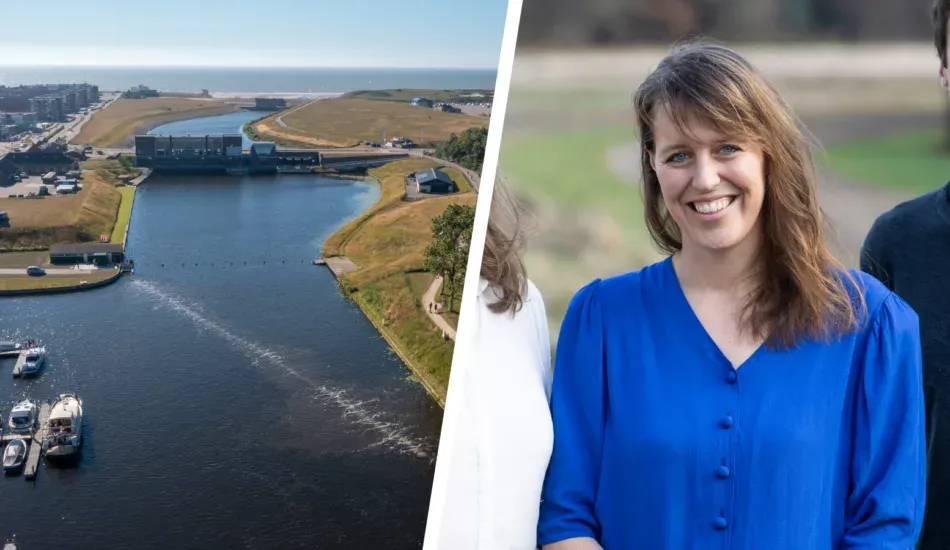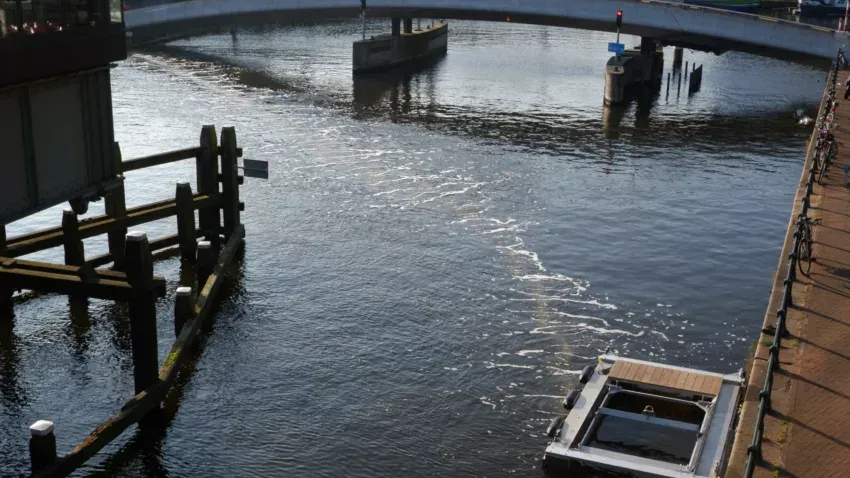The plastic soup is not limited to seas and oceans. The amount of plastic waste in canals, channels and rivers is also enormous. Indeed, pollution in oceans is largely caused by it. A Dutch start-up called The Great Bubble Barrier has the solution: a wall of bubbles. This allows plastic to be intercepted without hindering fish, birds or ships.

Like so many good ideas, The Great Bubble Barrier grew out of a conversation between friends. Francis Zoet, Anne Marieke Eveleens and Saskia Studer knew each other from teaching at a sailing school and in 2014 questioned their current jobs. There are so many social problems in the world; are their jobs focused on finding solutions to them?"
From a distance, they see Boyan Slat, founder of The Ocean Cleanup, taking his first steps with a technology to end the plastic soup in oceans. Fantastic, they think. But isn't there a lot of garbage floating in Amsterdam's canals, too? "Something is being thought up for the plastic in oceans, but we are letting the trash in canals float right past us," the sailing friends conclude. The seeds for a radical career switch have been sown.
Exit into the sea
The presence of plastic waste in streams, rivers and canals is a growing problem. Moreover, it is one of the main causes of the plastic soup in oceans, see Sweet, Eveleens and Studer. This is because rivers flow into the sea, transporting large amounts of plastic into international waters.
The friends devise a solution to it. This excels in simplicity - in essence, the solution consists of only three parts: a perforated tube, a collection tray and a compressor. Through the tube, which is placed at the bottom of rivers, canals or ditches, a compressor pumps air. Small air bubbles then shoot out of the holes and make their way to the surface of the water, forming a "wall of bubbles. Because the tube is placed diagonally on the waterway, the natural current creates a driving force that moves the plastic toward the wharf. The bubble wall stops floating waste and thus propels it to one point. There, there is a catch basin that collects the waste. The benefits? Fish and birds are not hindered by the screen of bubbles, and shipping can also proceed undisturbed.
Part-time toil
With the idea in mind, Sweet, Eveleens and Studer founded The Great Bubble Barrier in 2015, a start-up on which they worked part-time for the first few years. Soon Philip Ehrhorn joins the team, an environmental engineer from Germany who was already doing experiments with a similar idea. Years of toil follow to put The Great Bubble Barrier on the map.
"The whole period from 2015 to 2018 we worked part-time," Zoet says. "So a lot of working in the evenings. That was pretty tough. I myself was able to focus on The Great Bubble Barrier full-time from 2017, thanks to the help of friends and family. But my co-founders were still doing everything in between business at the time."
By little by little, the friends, now to be called associates, succeeded in proving their technology to the outside world. The Bubble Barriers appear in more and more locations: Amsterdam, Katwijk, Harlingen - even the Portuguese municipality of Vila do Conde is purchasing one. The installation in Amsterdam's Westerdok has been there the longest, now about five years.
.
85 percent catch
.Sweet has therefore been able to properly measure how much waste the system intercepts. "In Amsterdam we catch 80 kilos of waste per month, over 15,500 pieces of plastic," says Zoet. "It involves a lot of packaging material and plastic bottles, although the latter is decreasing slightly since the advent of deposit money. But we also catch larger items, such as screens, menus, chairs, road signs and paintings."
It is estimated that bubble screens can catch 86 percent of all litter in waterways, particles as small as one millimeter. Smaller is difficult for practical reasons. "A lot of organic material naturally grows under water," Zoet explains. "The catch basin has holes of one centimeter, but because of the organic material, within a few weeks that has become half a centimeter. If you were to make holes of a millimeter, they would be closed tomorrow."
Through much testing, the conditions under which the bubble screens can be effective are also slowly becoming clear. "We are now looking at waterways at least 15 meters wide and up to about 200 meters. 250 meters we might also just manage. In terms of depth, we have tested to about 7 meters."

Ten feasibility studies
.The system sounds so simple and effective that one wonders: why are there not already at least three Bubble Barriers in every municipality? Zoet: "That's because the routes with governments are long. The average length is about three to four years. We have done at least ten feasibility studies this year. They look at permit requirements, soil profiles, flow velocities, things like that. We are working on a lot of things at the same time, so it could just be that within two years we suddenly have ten Bubble Barriers in the water."
Financing
.In the meantime, the idea that originated almost a decade ago at the sailing school has gained considerable momentum. Things are going so well with The Great Bubble Barrier that Zoet has to think for a moment when asked what stumbling blocks she sometimes encounters. Finally, she thinks of one: raising funding. It's not a necessity for The Great Bubble Barrier, but it could advance further growth.
"We are still self-owned. That is, in the eight years of our existence we have never needed any investment. We have built up a sizable track record with clients, but may not show the steep growth curves that other impact start-ups do. Investors often find that less interesting." In addition, Zoet indicates that, ironically, an investment in her company carries too little risk. "As a result, we just don't fall into that category of investors who go for high risk, high return."
Policy hooks
.In the end, The Great Bubble Barrier would be heartened by tighter policies on plastic pollution. First of all, internationally; new global agreements that result in governments having to take mandatory action to reduce plastic waste in waterways. But broadening existing policies would also help, making it easier for local governments and organizations to install a Bubble Barrier in their municipalities.
"We find that many water boards, governments and commercial parties want a Bubble Barrier," Zoet said. "But if government agencies want to get something done, they have to find a hook within a policy package to hang the project on. Even if there is private funding for it. There has to be a good reason why a project is wanted, otherwise it is seen as unimportant. So for us, that's pretty crucial."
Sweet and her now fourteen colleagues now want to turn their eyes increasingly abroad. The installation in Portugal was the go-ahead for that. "Many different trajectories are underway. For example, in Asia, where we are busy in Indonesia and Thailand. At the same time, we are also working in the United States. Things are moving incredibly fast there, they are very set on public-private partnerships like this. So that's really nice to see."
Source: Change Inc.